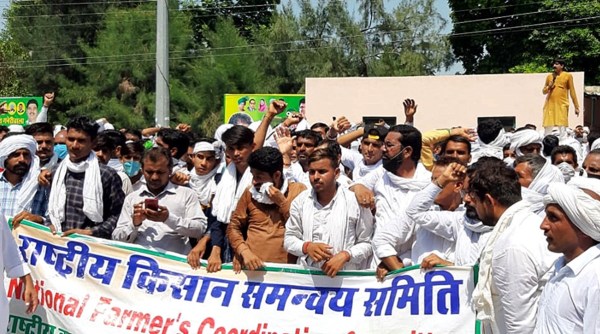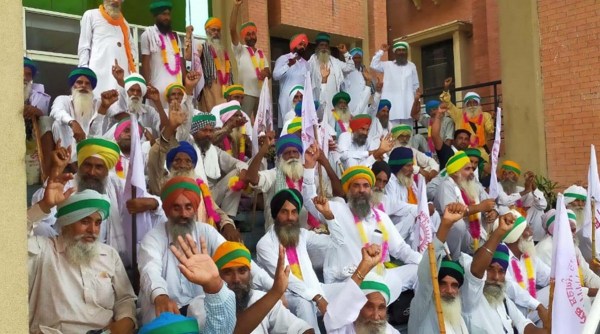
[ad_1]
, Anju Agnihotri Chaba
, Parthasarathi Biswas
| Jalandhar, New Delhi, Pune |
Updated: September 12, 2020 9:35:20 am
 During the protest on Friday. (Express Photo)
During the protest on Friday. (Express Photo)
On Thursday, farmer organisations in Haryana defied prohibitory orders imposed amid the pandemic to hold a rally at the Pipli wholesale grain market near Kurukshetra. Their target was three central laws promulgated through ordinances on June 5: The Farmers’ Produce Trade and Commerce (Promotion and Facilitation) Ordinance, the Essential Commodities (Amendment) Ordinance, and the Farmers (Empowerment and Protection) Agreement on Price Assurance and Farm Services Ordinance, 2020. These protests, preceded by sit-ins across Punjab, are expected to gather steam after September 14, when Parliament convenes for the Monsoon Session.
How widespread are the agitations in Haryana?
For now, these seem largely limited to Punjab and Haryana. Farmer leaders in Maharashtra, including Raju Shetti of Swabhimani Paksha and Anil Ghanwat of Shetkari Sanghatana, have actually welcomed the ordinances. Shetti, a two-time Lok Sabha MP, has called them “the first step towards financial freedom for farmers”.
The opposition by farmer groups in Punjab and Haryana, too, is primarily to the first ordinance that allows sale and purchase of crops to take place outside state government-regulated APMC (Agricultural Produce Market Committee) mandis. They probably have no real issues with the other two ordinances — which basically do away with the imposition of stockholding limits on foodstuffs (except under “extraordinary circumstances” such as war and natural calamities of grave nature) and facilitate contraction cultivation (wherein farmers can enter into agreements with buyers before any planting season).
 The protest in Sirsa on Friday. (Express Photo)
The protest in Sirsa on Friday. (Express Photo)
What is the first ordinance about?
In a letter to Sukhbir Singh Badal, president of the Shiromani Akali Dal (which is part of the ruling alliance at the Centre), Union Agriculture Minister Narendra Singh Tomar has said that the ordinance merely provides for “trade areas” outside the physical boundaries of APMC mandis. These would serve as an “additional marketing channel” for farmers, even as the APMCs “will continue to function”. The freedom of choice to sell outside the regulated mandis should help farmers realise better prices for their produce. Further, it “will motivate APMCs to improve their efficiency of operations substantially to serve the farmers better”. The APMCs can levy mandi fees and other charges as before, but these will be only in respect of transactions happening within the physical boundary of their principal marketing yards or sub-yards.
Also read | Rumblings in BJP-JJP as Haryana farmers protest central Ordinances
So, what’s fuelling the protests?
There are two drivers. The first is the farmers, who view the dismantling of the monopoly of APMCs as a precursor to ending the existing system of government grain procurement at assured minimum support prices (MSP). In 2019-20 alone, government agencies in Punjab and Haryana purchased 226.56 lakh tonnes (lt) of paddy and 201.14 lt of wheat , whose value – at their respective MSPs of Rs 1,835 and Rs 1,925 per quintal – would have been Rs 80,293.21 crore.
The ordinance itself does not mention anything, directly or indirectly, to suggest an end or phasing out of MSP-based government procurement. But farmer leaders contend that the true intent of the latest reforms is to implement the recommendations of the Shanta Kumar-headed High Level Committee on Restructuring of Food Corporation of India (FCI). This panel, which submitted its report in 2015, had called for FCI handing over all procurement operations in Punjab, Haryana, MP, Chhattisgarh, Odisha and Andhra Pradesh to state government agencies.
“The committee wanted that the Centre exit procurement and leave everything to the states. Where do they have the money for procuring and stocking so much grain? This… is only meant as an exit strategy for the Centre,” alleged Jagmohan Singh, general secretary of the Bhartiya Kisan Union (Dakaunda faction).
The Congress government in Punjab, too, passed a resolution in the Assembly on August 28 urging the Centre to make MSP-based procurement “a statutory right of the farmers”. Besides, it sought a “continuation” of such procurement through the FCI.
📣 Express Explained is now on Telegram. Click here to join our channel (@ieexplained) and stay updated with the latest
 The reaction to the ordinances has not been uniform. (Express Photo)
The reaction to the ordinances has not been uniform. (Express Photo)
What is the second driver for the protests?
That’s coming from the state governments and arhatiyas (commission agents) in mandis. The arhatiyas (Punjab alone has some 28,000 of them) provide platforms outside their shops, where the produce of farmers is unloaded, cleaned, auctioned, weighed and bagged, before being loaded and moved out. They receive a 2.5% commission over and above the MSP. These payments aggregated over Rs 2,000 crore in Punjab and Haryana last year.
States also earn substantial money from the various levies on the value of produce transacted in APMCs. Punjab’s annual revenues from mandi fees and a ‘rural development’ cess — which add up to 6% on paddy and wheat, 4% on basmati, and 2% on cotton and maize — are estimated at Rs 3,500-3,600 crore. All that would obviously get hit if trades were to move away from the mandis.
Is there a way out?
As already noted, the reaction to the ordinances has not been uniform. Shetti and Ghanwat believe farmers will benefit if processors, retailers or exporters were to invest in infrastructure for direct procurement. Farmers currently spend money on transporting their produce to the mandis, which they can save if purchases are made closer to their fields. But even these leaders feel the Centre should reach out to Punjab and Haryana farmers to dispel any misapprehensions. The hurried manner in which the ordinances were rammed through — during the height of the pandemic — may have also added to the trust deficit.
📣 The Indian Express is now on Telegram. Click here to join our channel (@indianexpress) and stay updated with the latest headlines
For all the latest Explained News, download Indian Express App.
© The Indian Express (P) Ltd
[ad_2]
Source link